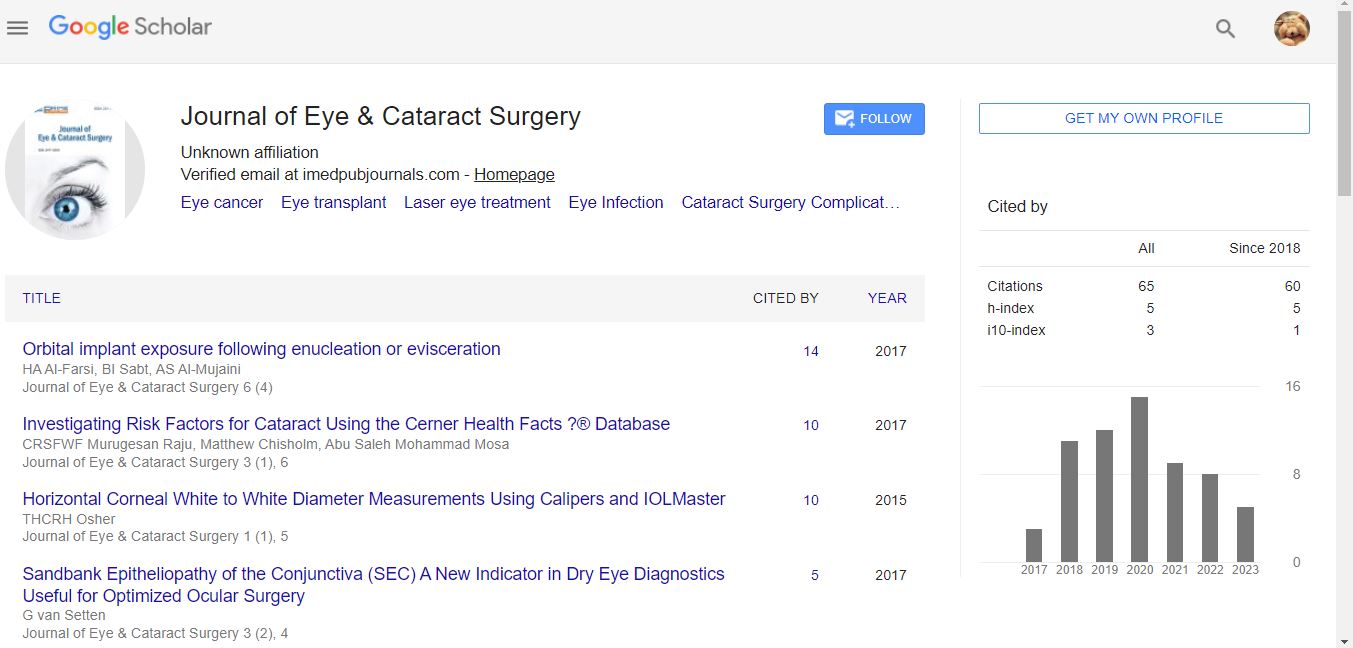Iva Dekaris*
Professor of Ophthalmology,University Eye Hospital “Svjetlost”and Associate Member of Croatian Academy of Sciences and Arts,Croatia
*Corresponding Author:
Iva Dekaris
Professor of Ophthalmology,University Eye Hospital “Svjetlost”and Associate Member of Croatian Academy of Sciences and Arts,Croatia
E-mail: iva.svjetlost@gmail.com
Citation: Dekaris I (2016) Welcome Letter. J Eye Cataract Surg 1:2. doi: 10.21767/2471-8300.10002
Copyright: © 2016 Dekaris I. This is an open-access article distributed under the terms of the Creative Commons Attribution License, which permits unrestricted use, distribution, and reproduction in any medium, provided the original author and source are credited.
Dear authors, reviewers and readers of Journal of Eye & Cataract Surgery It gives me great pleasure to welcome you as editorial board member of Journal of Eye & Cataract Surgery. As an anterior segment surgeon and a researcher with main interests in cataract, refractive surgery and corneal transplantation, I am looking forward to be actively involved in new developments in this field, especially since my work was always aimed to integrate basic research into the clinical practice.
Welcome Letter
Dear authors, reviewers and readers of Journal of Eye & Catar.
act Surgery
It gives me great pleasure to welcome you as editorial board member of Journal of Eye & Cataract Surgery.
As an anterior segment surgeon and a researcher with main interests in cataract, refractive surgery and corneal transplantation, I am looking forward to be actively involved in new developments in this field, especially since my work was always aimed to integrate basic research into the clinical practice.
It has been 66 years since Sir Harold Ridley was the first to successfully implant an intraocular lens at St Thomas' Hospital at London. Since then cataract surgery with an intraocular lens implant became one of the most common and the most effective surgical procedure in any field of medicine. Today surgeons annually implant more than 6 million lenses. The biggest changes that have changed cataract surgery and moved the field forward are the technical ones. Over the last 10 years since new lens technologies emerged, our cataract surgical options went through a dramatical change. With new premium intraocular lenses more and more surgical procedures are done on a clear lens, as purely refractive surgery enabling vision correction at all distances in patients with presbyopia. More lens options gave us additional benefits, but also more preoperative worries on how to select a proper intraocular lens for each particular patient. We have possibilities not just to treat spherical errors, but also the pre-existing astigmatism, with invention of so-called “personalized” toric lenses.
Novel technologies such as Femtosecond (FS) laser have the potential to revolutionize cataract surgery. With the increase use of premium intraocular lenses, precisely centred and measured capsulorhexis performed with FS laser is of great importance to achieve optimal visual outcomes. Moreover, FS lasers have the ability to pre-treat, segment or soften the lens to minimize the energy and trauma required for phacoemulsification and removal. However, there are still several challenges for the use of FS laser in cataract surgery that must be faced in the future.
Refractive surgery and cataract surgery are becoming more and more overlapped as the improvement in lens production enables better and better vision with premium lenses. However, we must be aware that “perfect” lens is yet to come.
Significant changes have occurred also in the field of corneal transplantation over the last decade. Nowadays, rare complications of cataract surgery such as keratopathies are also being successfully treated by lamellar transplantation where only a layer of cornea is changed by DSEAK, ultra-thin DSAEK and DMEK procedures. Increased success rate, quicker visual recovery and diminished rejection rate is accomplished with those novel surgical approaches.
The spectre of research in our field is indeed very broad and exciting, and strongly connected in all segments of the eye. I hope to provide quality assessment and processing of submitted articles and reviews and I’m looking forward in participating in the creation and development of this journal.

